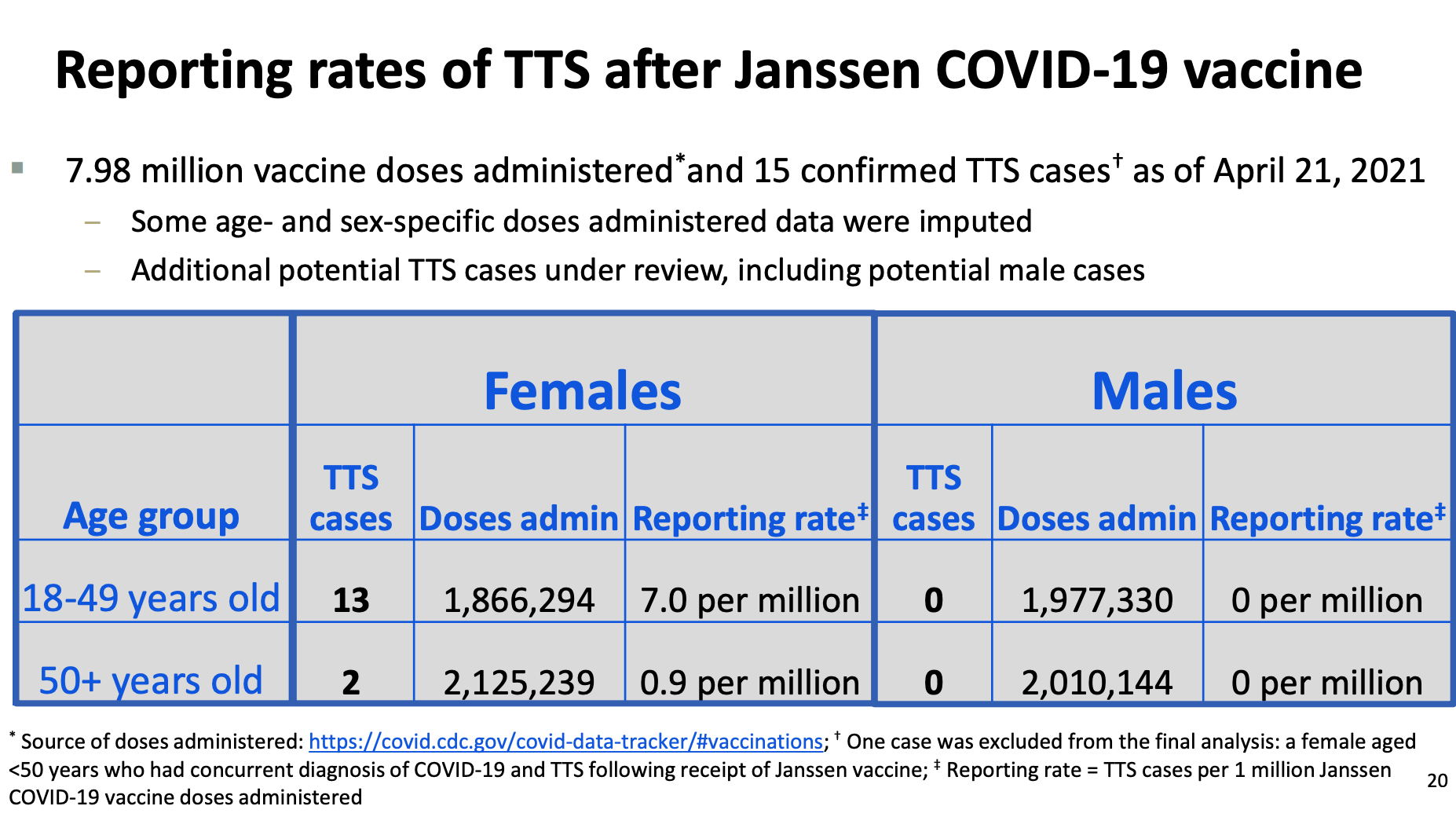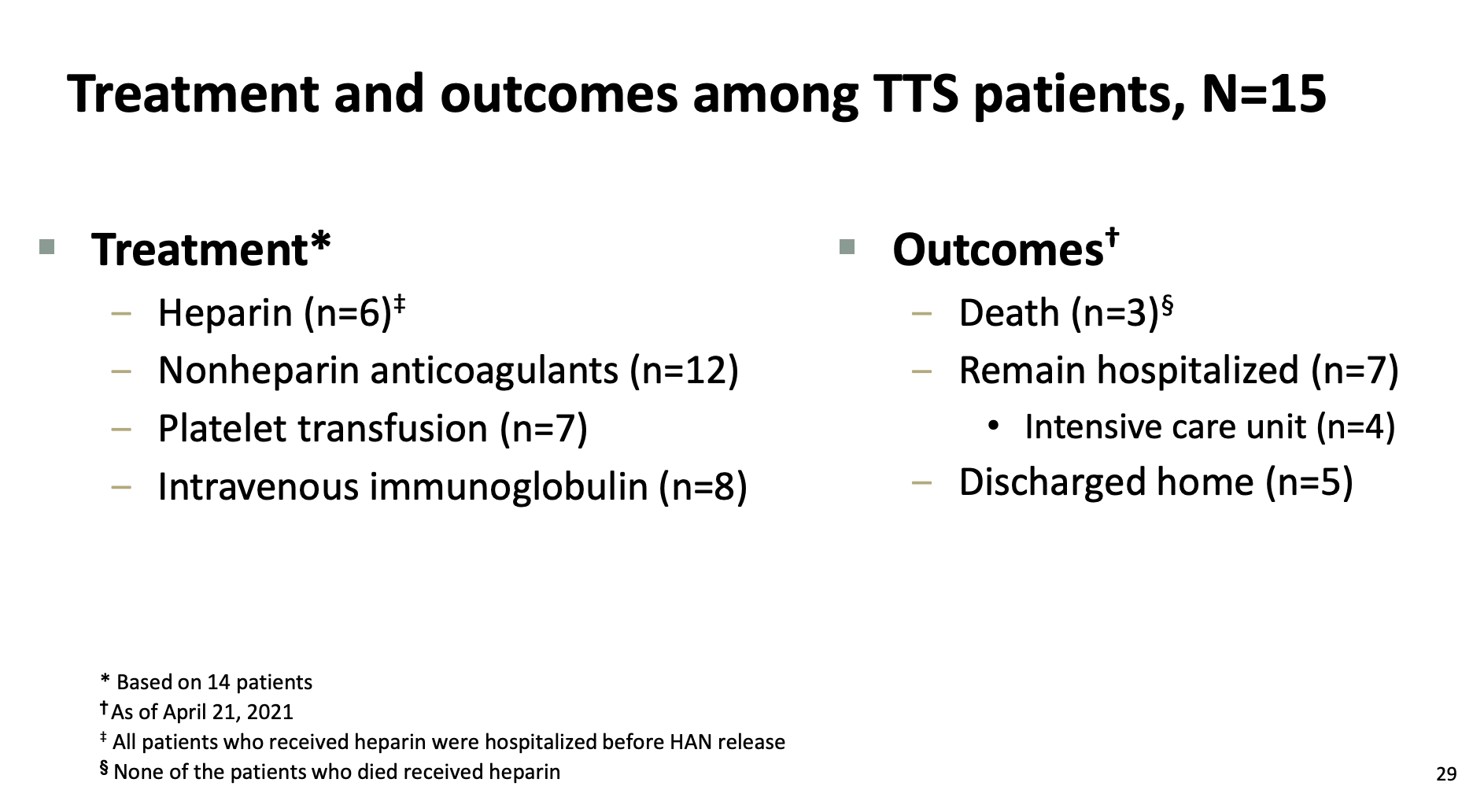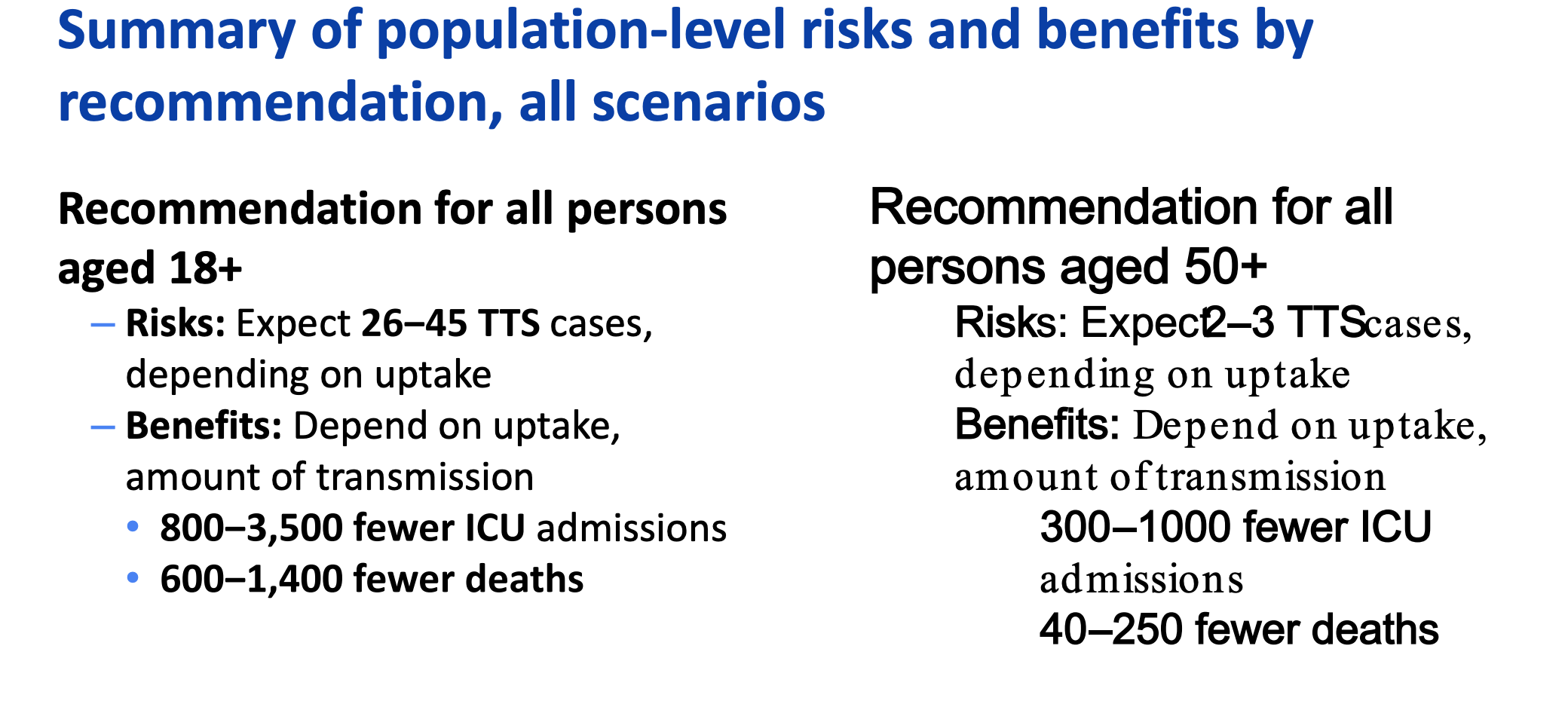The Risk-Benefit Calculations That Went Into The Decision to End the Pause of the J&J COVID-19 Vaccine
Projections of 600-1,400 fewer deaths were set against the risk of 26-45 cases of blood clots.
As expected, the CDC’s Advisory Committee on Immunization Practices voted yesterday to recommend resumption of the use of the Johnson & Johnson vaccine. Shortly afterward, the FDA and the CDC decided to lift the pause on the single-dose vaccine after determining the benefits outweigh the risks. They also issued two fact sheets, one for health professionals and one for people who have received the vaccine, about the risk of what is technically known as thrombosis-thrombocytopenia syndrome (TTS), which is characterized by blood clots (thrombosis) occurring when platelet levels are (thrombocytopenia). Normally, platelets, which are the "sticky" part of the blood that stanch bleeding, help form blood clots.
The 10-4 vote with one abstention came after a presentation about 15 cases of blood clots that have occurred among the 7.98 million people in the U.S. who received the J&J vaccines as of April 21. That works out to .000188%. Slides presented at the committee meeting by Tom Shimabukuro, M.D., M.P.H., MBA, a member of the vaccine safety team of the CDC’s Vaccine Task Force, also mentioned a 16th case affecting a 25-year-old male, but that case occurred in a pre-authorization trial.
All 15 of the blood clot cases detected during the post-authorization period have affected women. Shimabukuro reported that 12 have suffered cerebral venous sinus thrombosis, a rare type of stroke. Three of the women have died and seven are still in the hospital. Two of the women were taking oral contraceptives and seven are obese, according to data presented in Shimabukuro’s slides
Thirteen the 15 cases have been among women, ages 18 to 49, according to Shimabukuro’s presentation. Six were treated with heparin, which is now viewed as possibly contributing to the clotting. (The CDC and the FDA call the J&J vaccine the Janssen vaccine. Janssen is the subsidiary of the company that developed the vaccine.)


Sara Oliver, M.D., M.S.P.H., a CDC scientist and lead of the COVID-19 vaccines work group for the committee, presented risk-benefits calculations for resuming use of the J&J vaccine. The risk-benefit numbers vary depending on the underlying assumptions, including the rate at which the virus is spreading (the more transmission, the greater the benefit of vaccine’s protection against infection) and how many people get the J&J vaccine (the more people who get the vaccine, the greater the number of cases of blood clots). And the calculations in Oliver’s slides considered the J&J vaccine in isolation and did not make head-to-head comparisons with the Pfizer or Moderna vaccines.
The summary of the risk-benefit projections presented by Oliver show that over a six-month period between 26 and 45 cases of the blood clots (shown as TTS on the slides, the initials for thrombosis- thrombocytopenia syndrome) might occur if the vaccine is administered to adults ages 18 and older and depending on the uptake of the vaccine (less uptake would mean fewer cases).
On the benefit side, the projections presented by Oliver show between 600 and 1,400 deaths prevented and between 800 and 3,500 fewer ICU admissions by the J&J vaccine because of the protection afforded against COVID-19. The range reflects different transmission rates: the higher the transmission, the greater the benefit of the vaccine.

Oliver’s group also considered scenarios that would have limited the J&J vaccine to people ages 50 and older because most of blood clots have occurred in women younger than 50. If the vaccine was limited to those 50 and older, then the risk-benefit calculations shown to the committee yesterday show just two to three cases of blood clots, or TTS, occurring with the benefit of 40 to 250 fewer deaths and 300 to 1,000 fewer ICU admissions.
Changing to the assumption to moderate transmission and use of the J &J vaccine at 50% of the rate before the pause, Oliver’s slides show resuming use of the vaccine could results in 26 cases of blood clots over a six-month period among 9.8 million people vaccinated with the offsetting benefit of preventing of 1,435 deaths and 2,236 ICU admissions. Under the same circumstances but with an age limit of people ages 50 and older, Oliver’s slides show a risk-benefit projection of two cases of blood clots occurring among 3.6 million people vaccinated but also less benefit: the prevention of 257 deaths and 779 ICU admissions.

Oliver’s slides also made show risk-benefit comparisons between men and women. Overall men would benefit a little more in terms of prevented death and ICU admissions but have fewer case of blood clots. So, for example, for every million doses of the J&J vaccine, women, ages 18-49, are projected to suffer 15 cases of blood clots while men would suffer just two, according to the calculations presented in Oliver’s slides.
The risk-benefit math might argue for limiting the J&J vaccine by age or sex, and Oliver’s presentation includes a slide discussing the feasibility of recommending the J&J vaccine for specific populations. Among the drawbacks mentioned are providers needing to have different vaccines on hand for different groups, the difficulty of communicating the rationale for selective approval to the public, and the possible worsening of vaccine rate disparities among racial and ethnic groups.
Conversations With Perry and Friends
April 14th 2025Perry Cohen, Pharm.D., a longtime member of the Managed Healthcare Executive editorial advisory board, is host of the Conversations with Perry and Friends podcast. His guest this episode is John Baackes, the former CEO of L.A. Care Health Plan.
Listen
Breaking Down Health Plans, HSAs, AI With Paul Fronstin of EBRI
November 19th 2024Featured in this latest episode of Tuning In to the C-Suite podcast is Paul Fronstin, director of health benefits research at EBRI, who shed light on the evolving landscape of health benefits with editors of Managed Healthcare Executive.
Listen
Phase 3 Trial of Vertex’s Islet Cell Therapy for Type 1 Diabetes Under Way
April 23rd 2025Zimislecel is an allogeneic stem cell-derived islet cell therapy that could eliminate the need for insulin in those who have type 1 diabetes. Regulatory submissions are expected in 2026, and if approved, would be the second cell therapy for type 1 diabetes.
Read More










